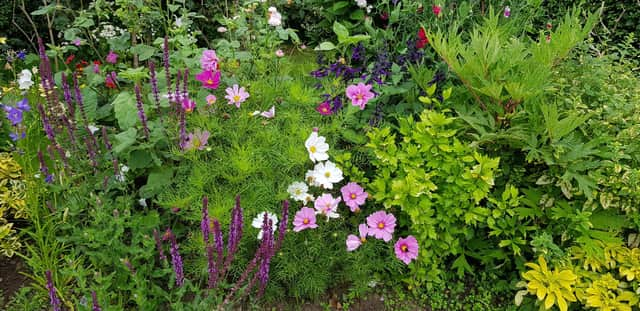GARDENING: The unmistakable aroma of the jam-making season


We`re currently harvesting vegetables and fruit, freezing the surplus of both, and the kitchen is a temporary jam-processing centre.
How much produce, I wonder, is lost at the eleventh hour simply because we failed to notice it`s readiness for picking? Garden peas and broad beans soon become dry and woody within the pod when left on the plant too long. Runner beans turn stringy if we`re not continually harvesting them young, even those cultivars deemed to be string-less. So, we pick fresh and
Advertisement
Hide AdAdvertisement
Hide Adblanch them before bagging-up en route to the freezer. Blanching is the process of plunging vegetables into boiling water for a brief period, then into cold water. This arrests enzymes that would otherwise cause a loss of texture, flavour and colour in deep freeze storage.
Black, red and whitecurrants were picked last week and stored on open trays in the freezer. This is essentially a holding operation until there's a lull in gardening activity. Then a decision is made on their use – fruit pies, preserve, etc. The strawberry crop is good as usual and continues, but this is a fruit of the moment, failure to pick daily leads to loss through rain damage. Jam-making, a limited batch at a time, is the delicious answer.
Similarly, the greenhouse peaches are ripening daily, that unmistakeable aroma filling the air. They're delicious of course but there's a limit to how many can be consumed at once, and they don`t freeze well. A pleasant problem that calls for improvisation.
Picking brambles, a.k.a. blackberries in the wild, was such an enjoyable childhood pursuit despite the thorns. So, in adulthood it’s fitting to have a constant reminder in the garden. But there`s more than sentimentality behind the cultivation of Blackberry `Loch Ness.` It's growing here on merit. There are no thorns to negotiate, the prolific fruits are large and ripen in late July rather than autumn, and it’s easily propagated by layering the sturdy stems. It also has decorative value with large, white blooms in May. As I examine the rapidly ripening fruits, bramble and apple pie, jam, and jelly-making spring to mind.
Advertisement
Hide AdAdvertisement
Hide AdPure pleasure is the best way to describe the effect of floral treats throughout our summer borders. The mixture of herbaceous perennials, annuals and shrubs was planted with pollinating insects in mind and involves lots of colour, so, it pleases us too. Some of the plant combinations were planned, others occurred by chance, but there should be surprises in a garden.
Last year we experienced success with the Sunflower `Little Dorrit` in a long, narrow border by the house wall. It grew to one metre, had multi-flower heads, and clearly tolerated the dry conditions. So, seed was saved for a repeat performance, and this time the flowers have opened with lavenders, and clary (both blue) for company. Add the tall Cosmos `Sonata Mix` and the feature has a thumbs up from bees and ourselves.
Salvias stand out so vividly in a border, and the lady of the house, having found a supplier in Sarah Raven, has really taken to them. Current favourites are `Amistad` and `Amethyst.` Apart from being attracted to their striking flowers, I`ve noticed several young shoots that have rooting potential! The hardiness and perennial nature of penstemons is a good enough reason to have them present, but there`s also the continuous flowering throughout summer. Bees cannot resist the tubular blooms, and they are so easily rooted from stem cuttings. In 2019 we added eight more cultivars to an existing collection, propagation followed and rooted offspring from those are
now flowering.
It always pays to keep the option of impulse buying open when examining plants for sale. If you like it enough you`ll find a place in the garden for it. Years ago, a potted rose caught the eye on a plant stall. The single rose-pink flowers were insignificant, stems covered in sharp thorns and leaves like those of a briar. The label was unintelligible but I recognised an acquaintance
Advertisement
Hide AdAdvertisement
Hide Adfrom the past, the sweet briar, Rosa rubiginosa `Lady Penzance.` Reaching for a young leaf to confirm identity, I rubbed it between finger and thumb to release the fragrance of ripe apples. Gotcha! It has occupied several spots in the garden over time but was never really satisfied with any until now. It`s settled in the semi-semi-shade of a silver birch, surrounded by comfrey, geraniums, oregano and euonymus. Enjoy your garden!